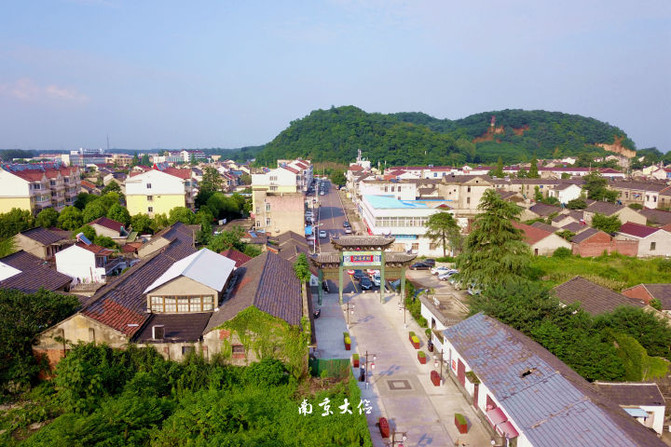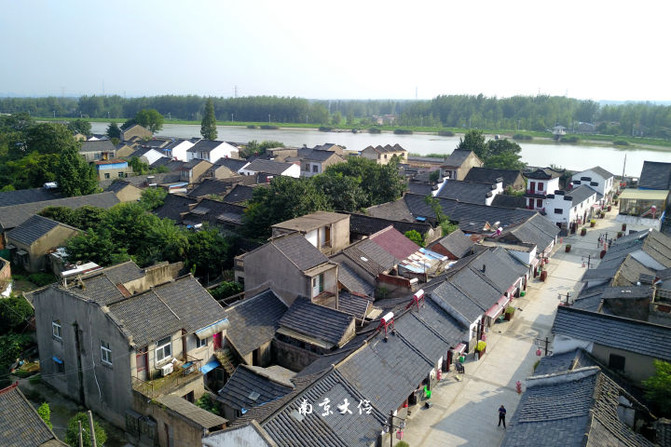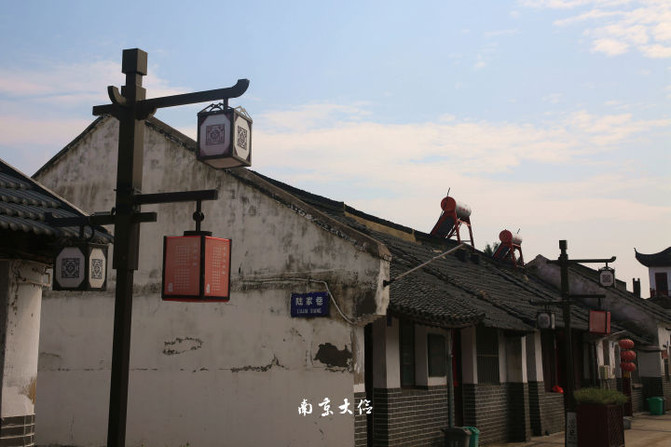Nanjing, a thousand-year-old town that flows in poetry, should also be filled with stories
"Throughout the ages, there is no hero to find, but Sun Zhong seeks a place. When dancing on the singing stage, romantic feelings are always blown away by the rain and the wind. The grass and trees in the setting sun are ordinary alleys where people once lived. Back then, the golden sword and iron horse swallowed thousands of miles like a tiger. In the Yuanjia Dynasty, the wolf was swept away, and the wolf lived in Xu City, and the wind was swept north. Forty-three years ago, I still remember in the sky, and the fire was on Yangzhou Road. Looking back, there is a sea of divine crow and crow drums under the Buddha and Beaver Temple. Who should ask, can Lian Po still eat when he is old?"
You should not be unfamiliar with this Song poem. Yes, it is "Yongyu Le-Reminiscing the Past in Beigu Pavilion in Jingkou" written by Xin Qiji in the Southern Song Dynasty. Someone once went to Beigu Mountain in Zhenjiang to find the Buddha fox temple mentioned in the poem. In fact, because they did not understand it, this Buddha fox fox temple is not in Beigu Mountain in Zhenjiang, but in Guabu Mountain in Guabu Town, Liuhe District, Nanjing. "Under the Buddha Lion Temple, there is a piece of divine crow club drums", describing the peaceful and prosperous situation here at that time.

Wang Yun in the Yuan Dynasty also visited the Buddha and Lion Temple in Guabu, and later wrote a poem titled "Buddha and Lion Temple". The poem said,"The mayor of Guabu was stationed in the countryside, and the Buddha and Lion Temple was in ruins." It was revealed that the Buddha Beaver Temple at this time seemed to have lost its beauty.

Buddha fox is actually a "Bi fox". Here, the word "Buddha" is pronounced bi, and it is one of the foxes. Tuobatao, Emperor Taiwu of the Northern Wei Dynasty, used this as the word. It is also said to be his nickname. He once built a palace on Guabu Mountain in Liuhe. This palace was later converted into a temple, named Taiwu Zhenjun Temple, and called it the Buddha Fox Temple among the people.

When someone sees me writing Guabu Mountain on it, they will ask if I wrote it wrong? In fact, we now call it Guabu Mountain. This mountain was originally called Taoye Mountain, also known as Guishan. In ancient times, this mountain faced the Yangtze River in the south. The water was called Bu. It is also said that the people of Wu sold melons by the river, so it is also called Guabu Mountain. Guabu Ancient Town was built around mountains and rivers. Historical records record that it was built in the sixth year of the Eastern Han Dynasty and the early Yuan Dynasty. At that time, it was the location of the famous ferry crossing that ran through the north and south of China. It was not until the Ming Dynasty that "Bu" was changed to "Bu" and it has been used to this day. Later, with the changes of age and geography, the river bank gradually moved away from this mountain, and the Chu River water system flowed through the other side of the ancient town, from which it merged into the Yangtze River.

In fact, in ancient times, Guabu was not just a small town. During the Southern Qi Dynasty, Qi County was set here and governed by the county. Guabu Mountain has a dangerous terrain and was a battleground for ancient military strategists. Many famous wars in history took place here, leaving many allusions. Xin Qiji's "Yuanjia is sloppy, the wolf is confined to Xu, and the wind is hurried to the north." It is about the "Battle of Yuanjia". In 450 AD during the Northern and Southern Dynasties, Emperor Wen of Liu Song of the Southern Dynasties launched the Northern Expedition of Yuanjia, but was defeated by Emperor Taiwu of the Northern Wei Dynasty. Later, Tuobatao of the Northern Wei Dynasty counterattacked Liu Song and sent troops from the north bank of the Yellow River in October to defeat the main force of the Song army. In December, he led troops here and directly threatened Jiankang (now Nanjing), the capital of the Southern Song Dynasty, across the river.

During the Northern and Southern Dynasties, in 432 AD in the Southern Song Dynasty (the ninth year of the Yuanjia Dynasty), Tan Daoji was granted the title of Sikong to guard Xunyang due to his many great achievements. In 436 AD (13th year of Yuanjia), Liu Yilong, Emperor Wen of the Song Dynasty, fell seriously ill and handed over to Liu Yikang, King of Pengcheng, to be in power. Liu Yikang was worried that Tan Daoji would rebel after Liu Yilong's death, so he forged an edict to summon Tan Daoji into the court. Before leaving, his family advised Tan Daoji not to go, for fear of disaster! However, Tan Daoji did not listen to advice and believed that he had not failed the country. As a result, Tan Daoji was arrested by Liu Yikang as soon as he arrived in Jiankang. When Tan Daoji was arrested, he pulled down his turban and smashed it hard to the ground."I will destroy your Great Wall for thousands of miles!" In the end, Tan Daoji, his son and trusted generals were executed in Jiankang. When the news spread to the Northern Wei Dynasty, the generals of the Wei army celebrated each other: "With Tan Daoji's death, there will be no one in the south to be afraid of!" After Tan Daoji's death, the Southern Dynasties turned on the defensive in terms of military situation, while the Northern Dynasties took the initiative and repeatedly marched south. The Later Northern Wei Dynasty marched south to Guabu Mountain on the north bank of the Yangtze River. This mountain was only 25 kilometers away from the Stone City, the Imperial City of the Song Dynasty in the Southern Dynasties. Liu Yilong, Emperor Wen of the Song Dynasty, climbed Stone City and looked north on the north bank of the Yangtze River with a worried expression. He said: "If Tan Daoji was still here, how could it have reached this point!" These are allusions such as "self-destruction of the Great Wall" and "celebrating each other with the crown".

During the Five Dynasties and Ten Kingdoms period, in the third year of Xiande of Zhou Shizong (956 AD), Zhao Kuangyin fought with the Southern Tang soldiers here and won a complete victory. The following year, Zhao Kuangyin defeated Li Jing of the Southern Tang Dynasty in Yuguabu with 100,000 troops. In the more famous Battle of Huangtiandang, Liang Hongyu beat a drum and shook Jinshan during the Southern Song Dynasty. Han Shizhong, the famous anti-Jin general, defeated the Jin soldiers in Huangtiandang with 8,000 people. More than 100,000 troops of the Jin Wushu Army were almost completely wiped out. The ancient battlefield of Huangtiandang is located on the river south of Guabu Mountain. This is now part of Longpao Town, Liuhe District Liuhe District, and the ruins of the ancient battlefield have also been restored. During the Taiping Rebellion, the Taiping Army repeatedly repelled more than 10,000 Qing troops here.

In addition to many wars showing the importance of its geographical location, it is also a transportation fortress. Guabu Ancient Ferry is a famous ferry crossing the ancient post roads running through north and south of China. It is also called the "Three Great Ancient Ferry", together with Zhenjiang Xijin Ancient Ferry and Yangzhou Guazhou Ancient Ferry, is connected to the Qixia Ancient Ferry on the south bank of the Yangtze River. However, now there is no trace of the ancient ferry crossings. There is only a huge stone standing on the bank of the Chu River at the end of the ancient town, with the inscription "Guabu Ferry". I learned from the local elderly that there were two ferries along the Chu River. Because of the development of the highway, the ferry lost its function and disappeared.

Due to its former north-south thoroughfare, many literati passed by or traveled here, and naturally left many beautiful poems behind. Currently, more than 100 poems describing the ancient town of Guabu can be found. Red palace lanterns are now hung on both sides of the restored ancient town's streets, and each lamp is printed with ancient poems describing Guabu, making a seemingly ordinary ancient town suddenly full of poetry.

What makes us fortunate is that through these poems, we can learn more about the history of Guabu Ancient Town. In addition to the above mentioned, let's talk about King Luo Bin's "Crossing the Melon Step","Holding a memorial to the secluded path, and singing the praises of the Lang to Guizhou. The stormy waves are suspicious of leaping horses, and the accumulated energy is like connecting oxen. The moon is clear and the yellow sand is clear, and the wind is strong at night. If you don't learn from the shadows of floating clouds, you will stay in your hometown." It tells the story of the third year of Yifeng (678), when King Luo Bin was ordered to be transferred near the capital Chang 'an after suppressing the barbarian rebellion in Sichuan and Yunnan. He was in a very happy mood. On the way back to Chang' an, he took a boat to Liuhe Guapu for a tour.

"The sun sets flat on the forest and the water's edge, and the city of Wucheng is covered with only blue color. Baotou recalled what happened at that time, and the shogunate was the youngest." This is a popular poem "Looking at Yangzhou by Guabu" written by 55-year-old Wang Anshi as he recalled his youth while passing through the Guabu Ancient Ferry.

In addition, there are Su Shi's "A Little Poetry Obtained in a Dream at Sugua Step to Show the People's Teacher", Yu Xin's "Commanding the Envoy to Crossing the Guava Step North", Mei Yaochen's "Climbing the Guava Step Mountain", Dong Bangzheng's "Guava Step Watching the Tide", etc., I won't list them one by one here, but if you like poetry, you can check the information.

After more than a thousand years of change, the ancient town has undergone tremendous changes. I went here a few days ago. The ancient town is still under restoration. A beautiful large archway has been erected on the street, and the stone slabs on the street have been replaced with new ones. The old houses are also refreshed, which makes me feel that the original juice and flavor have been lost. The old street is no longer "old", and the streets are relatively empty and there is no sign of prosperity. A local elderly man in the 60s told me that when he was young, the place was still very lively, and it was gradually deserted in recent years. Most of the young people went out to work and settled their new homes in the urban area. All the old houses here were vacant. During the renovation of the old street, most of the houses were almost dilapidated, and all of them had undergone major surgeries. Only a few old houses from the Republic of China were relatively well protected and were not touched much.

Despite this, I can still see traces of the prosperity of the ancient town. In the past, I walked through many ancient towns and walked through one street to the end. However, here is a cross street pattern, with two streets vertical and horizontal, which shows that the original street surface here is relatively large.

Because I had done some homework before I came here, trying hard to find what I wanted to see on the street and the things in those stories. Unfortunately, there were very few I could find. It was the poems on the palace lanterns that made the ancient town flow with poetry. charm. As the tourism resources of the ancient town, more historical stories should be explored and integrated, because there is no shortage of stories here, and allowing tourists to enter the ancient town is like walking into the long river of history and experiencing a historical immersion. For the renovation of old streets, there is still more room for improvement.

Next Article:Nanjing Happy Valley, the most luxurious in history, is here with TA's world's top roller coasters!
